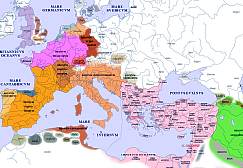

An Online Encyclopedia of Roman Emperors
Fabia (First Wife of Heraclius )
Lynda Garland
University of New England, New South Wales Fabia, the daughter of Rogas, an African from Libya, was betrothed to Heraclius prior to his accession. Apparently in preparation for his coup d' état she was present in Constantinople, together with Heraclius' mother Epiphania, as Heraclius waited near the capital with his army in late September or early October 610. Both women were imprisoned by Phocas in the monastery of Nea Metanoia, "New Repentance," presumably in an effort to cow Heraclius by using them as hostages as well as to prevent the women from working in their family's interest. The Green faction, however, did not allow this to go unchallenged and they released Fabia and Epiphania and took them to Heraclius on the island of Calonymus from where Heraclius launched his assault on the city. Phocas's resistance was unsuccessful and Heraclius and Fabia gained the throne. Fabia's coronation as Augusta and marriage to Heraclius took place on the day following their arrival, 5 October 610, immediately after Heraclius's coronation, the marriage ceremony being performed by the Patriarch Sergius. The details of Heraclius's coup vary markedly in the different accounts and only Theophanes mentions the wedding.[[1]]
As empress Fabia took the name of Eudocia. Her reign, however, was short. Her first child, Epiphania, was born on 7 July 611 in the suburban palace of Hiereia, on the Asiatic shore south of Chalcedon. Epiphania was followed by a son, Heraclius Constantine, after an interval of only 10 months. Once again the empress was confined in a suburban palace, this time that of Sophianae on the Asiatic shore near the city, on 3 May 612. Eudocia herself survived the birth, but died later that year on 13 August, at the Blachernae palace. The Patriarch Nicephorus in his Short History records that she died of epilepsy.[[2]]
Eudocia's body was conveyed to the palace by boat and her funeral procession on the following day was marked by an incident which demonstrated the veneration with which the imperial family was held by the populace at large. As her coffin was being carried through the crowded streets, a foreign maidservant accidentally spat out of an upstairs window, her spittle landing on the empress's robes as she lay in the open coffin. The spectators seized the poor girl and burnt her to death in the Forum Bovis, while her mistress promptly fled before she could suffer the same fate.[[3]] Eudocia's popularity is shown not only by this incident, but by the way in which Heraclius Constantine is referred to in the Ethiopic source of John of Nikiu, as the son of Eudocia --as opposed to his step-brothers, the offspring of his father's incestuous marriage to Martina.[[4]] Eudocia was buried in the Church of the Holy Apostles, Justinian's foundation, in a shrine of Thessalian green marble. Heraclius, despite his longstanding second marriage to his niece, was to be buried next to her some thirty years later.[[5]] Despite her coronation as Augusta Eudocia was not depicted on her husband's coinage, perhaps because she died shortly after the birth of her son, the occasion which would normally be celebrated by the empress's appearance on the coinage.
Bibliography
Haldon, J.F. Byzantium in the Seventh Century. The Transformation of a Culture, Cambridge, 1990.
Olster, D. The Politics of Usurpation in the Seventh Century, Amsterdam, 1993.
Stratos, A.N. Byzantium in the Seventh Century, vol. I. Amsterdam, 1968
Notes:[[1]]Theophanes AM 6102 [AD 609/10]; Chronicon Paschale, 701; John of Nikiu, Chronicle, 110.9; cf. John of Antioch, Excerpta de insidiis, chap. 149; Nicephorus, Short History, 1-2.
[[2]] Chron. Pasch., 702-3; Nicephorus, 2, 5; Theophanes, Chronographia, AM 6103 [AD 610/11] dates her death to 14 August.
[[3]] Nicephorus, 3.
[[4]] John of Nikiu, Chronicle, 116.4, 120.2.
[[5]] Constantine Porphyrogenitus, de ceremoniis, II.42.
Copyright (C) 2000, Lynda Garland. This file may be copied on the condition that the entire contents, including the header and this copyright notice, remain intact.
Comments to: Lynda Garland.
Updated:30 January 2000
For more detailed geographical information, please use the DIR/ORBAntique and Medieval Atlas below. Click on the appropriate part of the map below to access large area maps.
